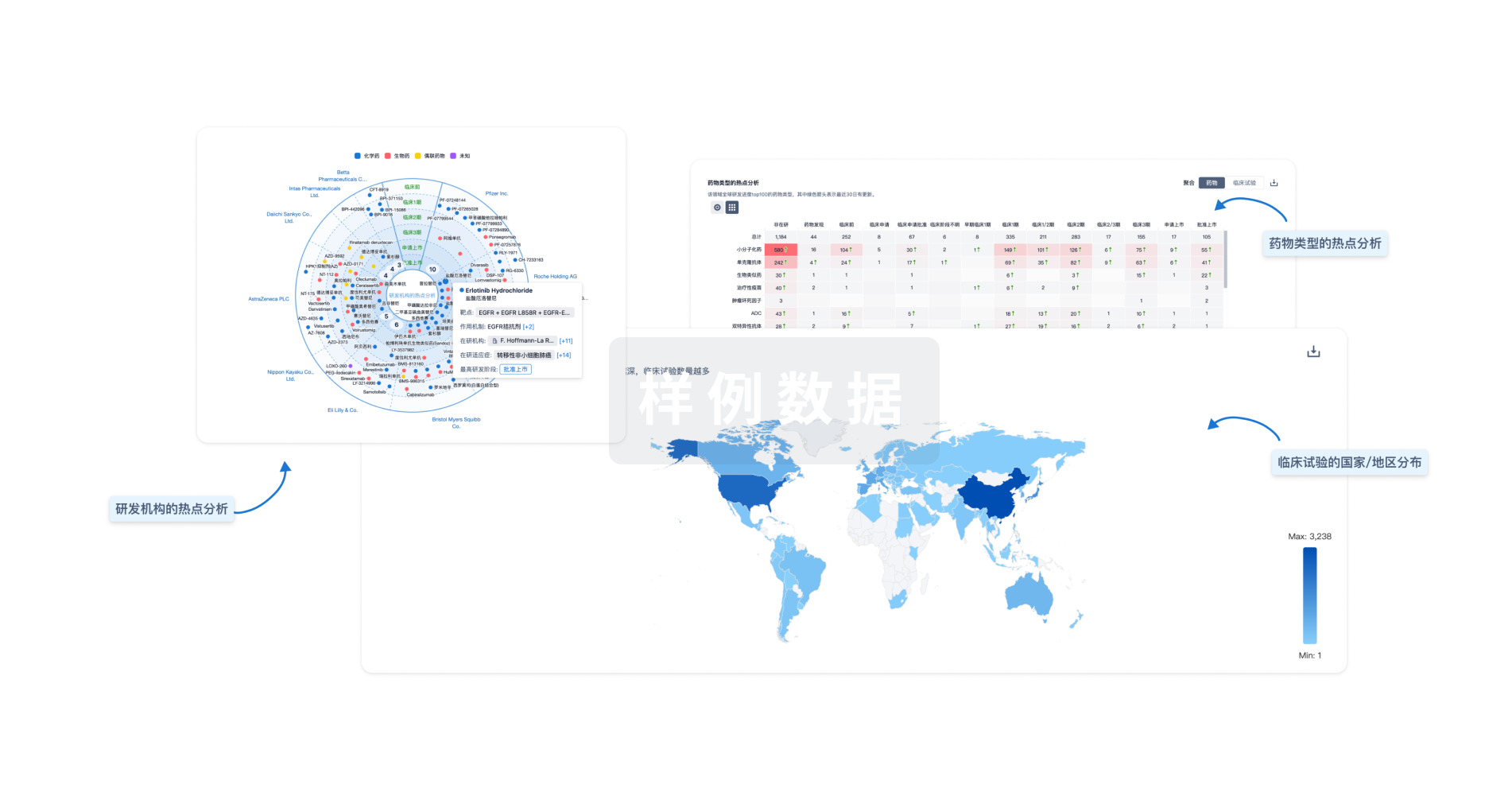预约演示
更新于:2025-05-07
Acute hepatitis B
急性乙型病毒性肝炎
更新于:2025-05-07
基本信息
别名 Acute Hepatitis B Infection、Acute hepatitis B、Acute type B viral hepatitis + [15] |
简介 A new infection by the hepatitis B virus, which can be transmitted by direct contact of infected blood with mucous membranes or open areas of the skin. Signs and symptoms may include loss of appetite, joint and muscle pain, low-grade fever and stomach pain. Two to six percent of adults progress to a chronic infection, while 90% of infants become chronically ill. A vaccine is available for those at risk. |
关联
5
项与 急性乙型病毒性肝炎 相关的药物靶点- |
作用机制- |
非在研适应症- |
最高研发阶段临床1期 |
首次获批国家/地区- |
首次获批日期1800-01-20 |
靶点 |
作用机制 NTCP 调节剂 |
非在研适应症- |
最高研发阶段临床前 |
首次获批国家/地区- |
首次获批日期1800-01-20 |
靶点 |
作用机制 IFNAR调节剂 |
在研适应症 |
非在研适应症- |
最高研发阶段临床前 |
首次获批国家/地区- |
首次获批日期1800-01-20 |
18
项与 急性乙型病毒性肝炎 相关的临床试验IRCT20240414061486N1
The Effect Of Training Program On Injuries Caused By Sharp Objects In Health Care Workers in 2024 - 2025
开始日期2024-09-21 |
NCT05264272
Disease Loads and Status of Treatment
The aim of study is to evaluate the current prevalence of HDV infection, and comprehensively analyze the interaction between HDV and HBV infections in the era of NAs in Taiwan. Investigators plan to set up a platform for HDV positive patients in Taiwan to invite sites or hepatologists who are interested in this field.
开始日期2022-01-01 |
IRCT20210329050786N1
Study of the Effect of Royal Jelly on the Healing Process of Patients Infected with Hepatitis B Virus and the Expression of Toll-like Receptors
开始日期2021-05-22 |
申办/合作机构 |
100 项与 急性乙型病毒性肝炎 相关的临床结果
登录后查看更多信息
100 项与 急性乙型病毒性肝炎 相关的转化医学
登录后查看更多信息
0 项与 急性乙型病毒性肝炎 相关的专利(医药)
登录后查看更多信息
2,319
项与 急性乙型病毒性肝炎 相关的文献(医药)2025-04-01·Journal of Viral Hepatitis
Prognosis of Acute HEV Infection in Patients With Liver Cirrhosis: A Retrospective Study of 628 Chinese Patients
Article
作者: Yu, Zhe ; Wei, Hongshan ; An, Wen ; Li, Mengqi ; Luo, Jing
2025-03-10·Zhonghua liu xing bing xue za zhi = Zhonghua liuxingbingxue zazhi
[Incidence and spatiotemporal clustering of hepatitis B in China, 2006-2020].
Article
作者: Wang, L ; Wang, F Z ; Yang, H ; Zhang, G M ; Liu, N ; Wang, H Q
2025-03-01·Vaccine
Global, regional, and national burdens of vaccine-preventable infectious diseases with high incidence among middle-aged and older adults aged 55–89 years from 1990 to 2021: Results from the global burden of disease study 2021
Article
作者: Xiao, Xi ; Kong, Tianqi ; Luo, Yinsong ; Liu, Jiaye ; Zhao, Dian ; Li, Xiaorui ; Liu, Chenye ; Hu, Yiyao ; Jiang, Yuxin
8
项与 急性乙型病毒性肝炎 相关的新闻(医药)2025-03-23
中华医学会肝病学分会肝炎学组和中华肝脏病杂志编辑委员会于2024年6月发表了《加速消除乙型肝炎病毒感染:扩大预防和治疗专家建议》(下称《专家建议》),对于包括慢乙肝全人群筛查、成人乙型肝炎疫苗接种、乙型肝炎病毒(HBV)DNA定量值的评价、启动抗病毒治疗的丙氨酸转氨酶(ALT)阈值、“不确定期”患者的治疗等《2022版乙肝防治指南》未达成共识的亟需解决的热点、难点问题进行了梳理,结合全球研究进展,提出建议。该建议旨在通过进一步扩大乙型肝炎的预防和治疗,早日实现世界卫生组织提出的“2030年消除病毒性肝炎作为公共卫生危害”的目标。本文就《专家建议》的要点进行介绍和解读,指导临床医生加强乙型肝炎的筛、诊、治、管。
1 一般人群HBV感染筛查、检测和管理
HBV本身不直接造成肝细胞损伤,而且肝脏本身再生及代偿功能较强,因此慢性HBV感染者一般不会出现明显的临床表现、肝功能可能长期在正常范围内。因此,慢性HBV感染的诊断主要依靠血清学和病毒学检测。根据Polaris发布的中国消除乙型肝炎进展数据,中国慢性HBV感染人数为7974.2万,诊断率仅仅为24%,治疗率更低,仅仅为15%。扩大人群筛查是实现早期诊断和及时治疗的关键措施之一。《专家建议》提出,对于≥18岁人群一生至少检测1次;持续暴露危险因素的高危人群应定期检测;检测项目包括乙型肝炎表面抗原(HBsAg)、乙型肝炎表面抗体(抗-HBs)和乙型肝炎核心抗体(抗-HBc)3项指标。
筛查后的临床管理也至关重要。筛查后临床管理包括诊断、疾病严重程度评估和抗病毒治疗。与现行HBV筛查策略比较,普遍筛查联合筛查后50%临床管理,到2030年,新发肝细胞癌(HCC)将减少7.3%,慢性乙型肝炎死亡将减少8.5%,累积HBV相关死亡将减少5%。《专家建议》提出,筛查结果HBsAg阳性者应进一步评估和治疗。特别指出,抗-HBs和抗-HBc同时阳性或单项抗-HBc阳性者,需进一步检测HBV DNA载量。3项均阴性者,建议接种乙肝疫苗。
2 成人乙型肝炎疫苗接种
以2013—2020年中国法定传染病报告系统中报告的乙肝病例为依据,对发病情况进行估算,2013—2020年中国估计急性乙肝发病率为4.6/10万,其中31~60岁发病占65.5%(2158/3297)。而且乙肝疫苗安全性高、可及性高。因此《专家建议》提出,建议无乙型肝炎疫苗接种史的≥18岁人群接种乙肝疫苗,特别是有乙肝高危因素的人群更应该接种;此外明确指出成人接种乙肝疫苗剂量及接种程序,首次接种后无应答人群应如何再次接种。
3 HBV DNA定量检测结果评价
检测HBV DNA应该采用高灵敏、具有更低检测下限(<10~20 kU/L)、更广线性范围(10~108~9 kU/L)的检测方法,以及时发现低病毒载量患者给予及时治疗,或及时发现治疗效果不佳患者及时给予调整治疗策略。HBV DNA定量检测试剂有的检测下限(LLOD)和定量下限(LLOQ)不同,简单说前者的HBV DNA载量较后者更低。《专家建议》指出,判断疾病自然史分期、启动抗病毒治疗、判断抗病毒治疗效果等应用的HBV DNA值,均以LLOQ为标准,认为只有检测到HBV DNA定量值,方可定为阳性。
4 ALT正常值上限与治疗阈值
各大指南对ALT的正常值均有不同推荐,大多数建议男性ALT正常值为30 U/L、女性为19 U/L;2018年AASLD指南建议男性ALT正常值为35 U/L,女性为25 U/L;而EASL和APASL指南建议男女ALT正常值均为40 U/L。2015年APASL指南定义了正常高值ALT,为0.5~1倍的正常值上限(ULN)。由于正常高值ALT的慢性乙型肝炎患者,肝组织学病变比例更高、肝病相关不良结局发生率更高,因此《专家建议》提出以正常高值作为ALT治疗的阈值,扩大治疗人群,可显著改善这部分患者肝病长期预后。
5 HBsAg阴性的乙型肝炎肝硬化患者抗病毒治疗策略
Kim等对829例HBsAg清除的慢性HBV感染者的回顾性研究发现,经3464人年的随访,肝硬化患者HCC年发生率为2.85%,显著高于非肝硬化患者(0.29%)。《专家建议》指出,对于HBsAg阴性的乙型肝炎肝硬化患者,都应该继续抗病毒治疗,争取肝硬化逆转或再代偿。对于功能性治愈的乙肝肝硬化患者,应继续治疗至肝硬化逆转;隐匿性乙型肝炎肝硬化患者(血清或肝组织HBV DNA阳性),应立即开始抗病毒治疗;HBV Pre-S/S突变株感染导致的乙肝肝硬化患者,如HBV DNA检测阳性,建议立即治疗,如HBV DNA阴性,应肝活检后决定是否抗病毒治疗。
6 临床(功能性)治愈的优势人群
由于聚乙二醇干扰素(PegIFN)α相比于核苷类似物(NAs),不良反应相对较多,目前仍建议选择优势人群采用Peg-IFN α单药或联合治疗。目前中国很多研究探讨经治或初治慢乙肝患者Peg-IFN α治疗的临床治愈率,并推荐优势人群。“珠峰项目”5年数据报告,NAs经治的基线HBsAg≤500 kU/L慢乙肝患者,联合Peg-IFN α治疗至48周,HBsAg清除率为42.9%。“破冰项目”2年数据显示,初治乙型肝炎e抗原(HBeAg)阴性、ALT正常慢性HBV感染者,如基线HBV DNA<1000 kU/L,HBsAg<500 kU/L,Peg-IFN α治疗48周临床治愈率高达52.4%。基于此,《专家建议》推荐了临床治愈的优势人群。
7 “不确定期”的定义及其治疗策略
“不确定期”患者难以被自然史分期明确分期,主要包括不能明确区分HBeAg阳性慢性HBV感染者与HBeAg阳性慢性乙型肝炎(CHB)患者,以及不能明确区分HBeAg阴性HBV感染者与HBeAg阴性CHB患者。相较于真正的免疫耐受期或非活动期人群,这部分患者疾病进展风险相对较高,也可能需要抗病毒治疗。《专家建议》指出,HBeAg阳性“不确定期”患者,建议做肝活检,根据组织学改变或无创检测评估决定是否抗病毒治疗;HBeAg阴性“不确定期”患者,只要HBV DNA阳性,建议抗病毒治疗。
8 合并感染和并发症患者的抗病毒治疗
关于HBV感染者同时存在人类免疫缺陷病毒、丙型肝炎病毒、丁型肝炎病毒感染的情况,很多研究分析比较了单独感染和合并感染患者的不良临床结局的发生情况,研究结果提示合并其他病毒感染的HBV感染者肝功能更差、肝硬化及肝癌发生率更高。存在代谢相关危险因素的患者,包括肥胖、高血压病、高脂血症、糖尿病,代谢危险因素与HCC发生正相关。因此,《专家建议》提出,对于合并其他病毒感染及代谢相关危险因素的慢性HBV感染者,应积极抗病毒治疗。
除了以上8个部分的建议以外,《专家建议》推荐简化的慢乙肝治疗理念,优先评估HBV DNA和血清学指标,然后考虑ALT和患者年龄,再考虑家族史和疾病严重程度及进展风险,另外在抗病毒治疗的同时,要联合抗纤维化治疗。《专家建议》的目的在于成人进行普遍筛查,科学地指导未感染者乙型肝炎疫苗接种;对HBV感染者进行评估、治疗和长期随访管理,最大限度地让新版指南中关于扩大抗病毒治疗的理念得以惠及更多患者,让符合适应证的患者尽早启动治疗,向乙型肝炎全治迈进一大步。
相关阅读
23%乙肝患者达到临床治愈!NEJM:侯金林领衔新疗法,探索停药后持续“清除”病毒
中国乙肝患者约7500万!《柳叶刀》子刊:约3000万人不知晓已感染
《柳叶刀》子刊:停药后持续“清除”乙肝感染24周,创新药助力功能性治愈
全球乙肝感染者,65%在亚太地区!《自然》子刊:关注8大关键策略
向治愈乙肝进发!95%中国患者需考虑抗病毒治疗,4类人群应尽快治疗
欢迎投稿:学术成果、前沿进展、临床干货等主题均可,点此了解投稿详情。
免责声明:药明康德内容团队专注介绍全球生物医药健康研究进展。本文仅作信息交流之目的,文中观点不代表药明康德立场,亦不代表药明康德支持或反对文中观点。本文也不是治疗方案推荐。如需获得治疗方案指导,请前往正规医院就诊。
分享,点赞,在看,传递医学新知
疫苗临床研究
2024-11-16
·丁香园
乙肝是乙型肝炎病毒感染导致的肝脏炎症,是威胁我国人群健康最重要的传染病之一,传播途径多样,可通过密切接触、母婴、血液和性传播。近九成感染者不会出现临床症状,而后,部分感染者可发展为慢性迁延性肝炎或原发性肝癌,对健康危害大,因此实验室诊断至关重要。
关于乙肝的实验室诊断,乙肝两对半是必须占有很大一席之地。实际上 HBV 的免疫学标记一共 3 对,分别是 HBsAg(乙肝表面抗原)、HBsAb(乙肝表面抗体);HBeAg(乙肝 e 抗原)、HBeAb(乙肝 e 抗体);HBcAg(乙肝核心抗原)以及 HBcAb(乙肝核心抗体)。
由于 HBcAg 在血清中不易检出,所以只检测剩下的两对抗原抗体和一个单独的乙肝核心抗体,俗称两对半。
乙肝两对半
要知道怎么解读乙肝两对半,还是必须看看乙肝两对半(5 项)分别意味着什么?
作为感染届首屈一指的大哥大,乙肝病毒有双层衣壳,表面抗原位于外衣壳、e 抗原和核心抗原位于内衣壳,分别是 HBV 内衣壳蛋白的分泌型和结构型。
01、HBsAg(乙肝表面抗原)
顾名思义,既然是表面抗原,所以它位于乙肝病毒的表面。因为是在表面,所以在乙型肝炎患者血清中最先出现,在急性肝炎潜伏期即可出现阳性。是乙肝早期诊断和普查的指标。
02、HBsAb(乙肝表面抗体)
是机体针对乙肝表面抗原产生的抗体,是一种保护性抗体,可以暴揍表面抗原,所以在机体感染或接种乙肝疫苗后会出现。
HBsAg 与 HBsAb 同时阳性可能是不同亚型重复感染或病患正处于血清转换期,即 HBsAg 消失,同时伴 HBsAb 出现。血清转换期为临床上慢性乙肝治疗的最终目标,对临床个体化治疗有重要的指导意义。
03、HBeAg(乙肝 e 抗原)
乙肝 e 抗原是 HBV 内衣壳蛋白的分泌型,是一种可溶性抗原,主要存在于乙肝患者的外周血中,为病毒复制及传染性强的标志,一般出现的比 HBsAg 稍晚。
04、HBeAb(乙肝 e 抗体)
是机体针对乙肝 e 抗原产生的抗体,一般出现于 HBeAg 阴转后,阳性表示患者处于急性肝炎恢复期,病毒复制水平低,传染性下降,病变趋于静止。
HBeAg 和 HBeAb 同时阳性可见于 HBeAg 血清学转换,同样对临床个体化治疗有重要意义,是目前临床上慢性乙肝治疗的近期目标。
05、HBcAg(乙肝核心抗原)
乙肝核心抗原是 HBV 内衣壳蛋白的结构型,存在于受感染的肝细胞核内,是个死肥宅,所以血液中含量甚微,不易检出。但是不是不出门就察觉不了的,因为它的抗原性强,感染早期即可刺激机体产生 HBcAb。
06、HBcAb(乙肝核心抗体)
作为针对 HBcAg 的抗体,简直是抗体届的耻辱,这丫并不会对乙肝病毒实施打击报复,它的存在只是提醒你 HBcAg 的存在和曾经存在过,你正在感染或者曾经感染,因为无论病毒是否被清除,此抗体均为阳性,可持续数年。
总结一下,HBsAg 最早出现、HBeAg 意味着病毒复制及传染性强的标志、HBcAb 提示正在感染或者既往感染。
乙肝两对半的结果解读
01 全不阳
HBsAg:⛔
HBsAb:⛔
HBeAg:⛔
HBeAb:⛔
HBcAb:⛔
🈯未感染过乙肝,对乙肝病毒没有免疫力,需要接种乙肝疫苗。
02 阳一项
HBsAg:➕
HBsAb:⛔
HBeAg:⛔
HBeAb:⛔
HBcAb:⛔
🈯因为 HBsAg 最早出现提示感染潜伏期后期或携带者,但是 HBeAg 阴性提示感染性不强。
HBsAg:⛔
HBsAb:➕
HBeAg:⛔
HBeAb:⛔
HBcAb:⛔
🈯理想状态,表示乙肝疫苗接种成功,或者感染乙肝康复具有免疫力。
HBsAg:⛔
HBsAb:⛔
HBeAg:➕
HBeAb:⛔
HBcAb:⛔
🈯 HBsAg 阴性不能完全排除乙肝、单独 HBeAg 阳性提示乙肝非典型急性感染,但是很少有 HBeAg 单独阳性者。
HBsAg:⛔
HBsAb:⛔
HBeAg:⛔
HBeAb:➕
HBcAb:⛔
🈯一般 HBeAg 阴转后才会出现 HBeAb,所以提示感染趋向恢复,一般无传染性。
HBsAg:⛔
HBsAb:⛔
HBeAg:⛔
HBeAg:⛔
HBcAb:➕
🈯 HBcAg 抗原性很强,但是检不出,所以 HBcAb 阳性提示 HBcAg 的存在,表示感染很早期,或者既往感染过后恢复期。
03 阳两项
HBsAg:➕
HBsAb:➕
HBeAg:⛔
HBeAb:⛔
HBcAb:⛔
🈯一般情况只有 HBsAg 消失以后才会出现 HBsAb,但是可见于乙肝病毒亚临床感染早期,病毒和抗体共存,或者不同亚型 HBV 二次感染等比较少见的情况。
HBsAg:➕
HBsAb:⛔
HBeAg:➕
HBeAb:⛔
HBcAb:⛔
🈯大二阳,HBsAg 提示感染,病毒复制活跃,传染性强。
HBsAg:➕
HBsAb:⛔
HBeAg:⛔
HBeAb:➕
HBcAb:⛔
🈯急性感染趋向恢复、传染性弱。
HBsAg:➕
HBsAb:⛔
HBeAg:⛔
HBeAb:⛔
HBcAb:➕
🈯小二阳,恢复期、传染性弱,长期持续易癌变。
HBsAg:⛔
HBsAb:➕
HBeAg:➕
HBeAb:⛔
HBcAb:⛔
🈯非典型肝炎。
HBsAg:⛔
HBsAb:➕
HBeAg:⛔
HBeAb:➕
HBcAb:⛔
🈯感染已恢复。
HBsAg:⛔
HBsAb:➕
HBeAg:⛔
HBeAb:⛔
HBcAb:➕
🈯恢二阳,乙肝恢复期,已有免疫力。
HBsAg:⛔
HBsAb:⛔
HBeAg:➕
HBeAb:⛔
HBcAb:➕
🈯乙肝病毒非典型急性感染。
HBsAg:⛔
HBsAb:⛔
HBeAg:⛔
HBeAb:➕
HBcAb:➕
🈯既往感染,急性乙肝恢复期,基本无传染性。
04 阳三项
HBsAg:➕
HBsAb:⛔
HBeAg:➕
HBeAb:⛔
HBcAb:➕
🈯大三阳,存在感染且病毒复制活跃。
HBsAg:➕
HBsAb:⛔
HBeAg:⛔
HBeAb:➕
HBcAb:➕
🈯小三阳,恢复期、传染性弱、长期持续易癌变。
HBsAg:⛔
HBsAb:➕
HBeAg:⛔
HBeAb:➕
HBcAb:➕
🈯恢三阳,乙肝恢复期,已有免疫力。
HBsAg:➕
HBsAb:➕
HBeAg:⛔
HBeAb:⛔
HBcAb:➕
🈯乙肝病毒亚临床感染早期、或不同亚型 HBV 感染。
HBsAg:➕
HBsAb:➕
HBeAg:⛔
HBeAb:➕
HBcAb:⛔
🈯乙肝病毒亚临床感染或非典型肝炎。
HBsAg:⛔
HBsAb:⛔
HBeAg:➕
HBeAb:➕
HBcAb:➕
🈯急性乙肝病毒感染中期。
HBsAg:⛔
HBsAb:➕
HBeAg:➕
HBeAb:⛔
HBcAb:➕
🈯乙型肝炎病毒亚临床感染或非典型肝炎。
05 阳四项
HBsAg:➕
HBsAb:⛔
HBeAg:➕
HBeAb:➕
HBcAb:➕
🈯急性乙肝感染趋向恢复,或者为慢性乙肝病毒携带者。
HBsAg:➕
HBsAb:➕
HBeAg:➕
HBeAb:⛔
HBcAb:➕
🈯乙肝病毒亚临床感染或非典型肝炎。
这么多排列组合的表格要都记下来是不可能的,所以理解了两对半每一项的意义,才能帮助理解这些结果出现的原因,对于比较少见的情况,具体操作具体分析。
本文首发于丁香园旗下专业平台:丁香园检验时间
参考文献:
[1] 王功遂,王曼曼,明朗,姜湘宁,陈乐无,谢秋里,刘梅华.HBeAg 定量测定在慢性乙型肝炎诊断和治疗中的价值 [J]. 中华传染病杂志,2004 (04):38-41.
[2] 倪语星,尚红,刘运德,王辉。临床微生物学检验 [M]. 人民卫生出版社.2012.1
[3] 王兰兰,许化溪,欧启水,秦雪。临床免疫学检验 [M]. 人民卫生出版社.2012.1
疫苗临床研究
2024-07-28
7月28日是世界肝炎日,今年我国的宣传主题是“消除肝炎,积极行动”。肝脏作为人体重要的代谢和解毒器官,被称为人体内的“化工厂”,承担着超过500种不同的重要功能。
随着现代生活节奏的加快,不良的生活习惯、环境污染等因素,肝脏疾病发病率逐年上升。中国相关肝病流行病学数据显示,包括慢性肝炎、脂肪肝和肝硬化在内,我国慢性肝病患者人数可能超过4亿[1]。因此,了解肝脏的基本知识,提高保肝、护肝意识,对维护我们的肝脏健康至关重要。
体检发现肝功能指标异常就是肝功能受损吗?
肝脏的功能十分复杂,包括合成、解毒、消化、免疫等多种功能。体检发现的肝功能生化指标异常并不能代表肝功能不全或受损。
但我们也不能无视这些异常指标,必要时应完善相关检查,以明确病因并采取相应的治疗措施。如果是由非病理因素引起的肝功能异常,如某些药物的影响,那么遵医嘱停止服用这些药物可能有助于改善肝功能;如果是由病理因素导致的肝功能异常,如肝炎、肝硬化等,那么需要遵医嘱进行针对性治疗,以免延误病情。
“大三阳”比“小三阳”更危险吗?
表面抗原和e抗原是乙肝病毒的结构成分,来源于乙肝病毒,只要这两种抗原阳性就说明已经被乙肝病毒感染。“大三阳”是指表面抗原阳性、e抗原阳性和核心抗体阳性,提示乙肝病毒复制活跃,含量高,传染性强。“小三阳”是指表面抗原阳性、e抗体阳性和核心抗体阳性,较“大三阳”来说,病毒复制活跃程度低,病情相对稳定。
无论是“大三阳”还是“小三阳”,发生肝硬化或者肝癌的危险性是一样的,都应引起重视,有抗病毒治疗指征时要及早进行抗病毒治疗以抑制乙肝病毒复制,延缓病情发展,降低肝硬化、肝癌的发生率。
乙肝可以治愈吗?
通过规范合理的治疗,乙肝是可以实现临床治愈的!大部分急性乙肝患者在得到及时、有效的治疗后都可以实现临床治愈,并有可能终身具有免疫力。对于慢性乙肝患者来说,当前的治疗方法主要集中在控制病毒复制、保护肝脏功能和减少肝脏炎症等方面,通过持续的抗病毒治疗,许多患者能够控制病情,减少并发症的发生。
随着医学研究的不断进步,未来可能会有新的治疗方法出现,为乙肝患者带来更好的治愈希望。患者和患者家属应该保持积极的心态,积极配合医生的治疗建议,坚持规律的生活方式和药物治疗,以达到最佳的治疗效果。
什么是药物性肝损伤?哪些药物可能导致药物性肝损伤?
药物性肝损伤是指由药物或其代谢产物引起的肝脏损害,我国引起肝损伤的最常见药物包括传统中药/草药和膳食补充剂、抗结核药物、抗肿瘤药物和免疫调节剂等[2]。不同药物引起的肝损伤机制可能有所不同,且药物性肝损伤的发生和程度也会因个体差异而异。
在使用任何药物时,都应遵循医生的建议和指导,注意药物的剂量和使用时间,避免滥用药物,以免发生药物性肝损伤。另外,定期进行肝功能检查也是预防药物性肝损伤的重要手段。
如何发现药物性肝损伤?
药物性肝损伤的诊断是一个综合的过程,需要进行层层筛查的“排除性诊断”[2,3],同时综合考虑患者的用药史、临床表现、实验室检查以及排除其他肝病等因素。
此外,在用药过程中,与专科医生进行充分沟通也是十分重要的。患者应尽量避免使用可能对肝脏造成损害的药物。本身就有肝病基础或肝病史的患者在用药前必须明确告知医生。
患者在确诊药物性肝损伤后,停止使用相关药物,并进行保肝治疗,大部分情况下都可以顺利恢复正常。
停用可疑药物后,药物性肝损伤会自愈吗?
药物性肝损伤是否能自愈取决于其严重程度以及受损的细胞类型。
单纯的肝细胞损伤型药物性肝损伤通过积极的保肝治疗,如使用异甘草酸镁等抗炎药物,大部分患者的肝功能可以完全恢复正常。从肝纤维化、肝硬化的发生率等长期预后来看,这类患者的临床结局通常较好。
严重的药物性肝损伤,如出现高黄疸、凝血功能异常等症状,则应尽快停用相关损坏肝脏的药物,并积极接受保肝治疗。
注意:药物性肝损伤病情不一,同一种药物可能引起不同类型的肝损害。早期诊断、治疗和及时停药是改善预后的关键。
参考资料:
1. Jia Xiao, at al. Global liver disease burdens and research trends: Analysis from a Chinese perspective. J Hepatol. July 2019, 71(1): 212–221.
2. 中华医学会肝病学分会药物性肝病学组. 中国药物性肝损伤诊治指南(2023年版) [J] . 中华肝脏病杂志, 2023, 31(4) : 355-384.
3. 中华医学会, 中华医学会杂志社, 中华医学会肝病分会, 等. 药物性肝损伤基层诊疗指南(2024年) [J] . 中华全科医师杂志,2024, 23.
* 本资料为专业医学资料,旨在促进医药信息的沟通和交流,仅供医疗卫生专业人士参考,非广告用途;任何处方请参考产品最新详细处方资料
内容来源:晴医荟公众号
›› 谢承润应邀出席福布斯中国U30十周年峰会 勉励年轻人自我修炼、坚定成长
›› 彰显创新实力!正大天晴连续9年荣登中国药品研发综合实力百强榜前3强
›› Ⅰ类创新药三连发!正大天晴新一代ALK抑制剂依奉阿克获批上市
分析
对领域进行一次全面的分析。
登录
或

生物医药百科问答
全新生物医药AI Agent 覆盖科研全链路,让突破性发现快人一步
立即开始免费试用!
智慧芽新药情报库是智慧芽专为生命科学人士构建的基于AI的创新药情报平台,助您全方位提升您的研发与决策效率。
立即开始数据试用!
智慧芽新药库数据也通过智慧芽数据服务平台,以API或者数据包形式对外开放,助您更加充分利用智慧芽新药情报信息。
生物序列数据库
生物药研发创新
免费使用
化学结构数据库
小分子化药研发创新
免费使用




